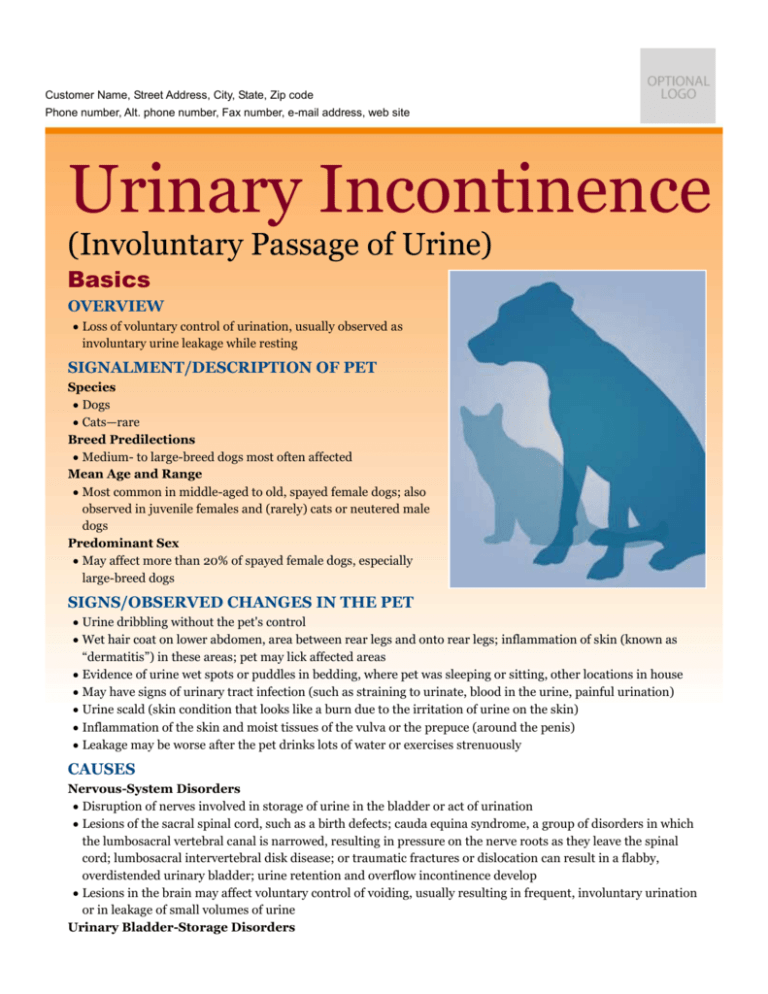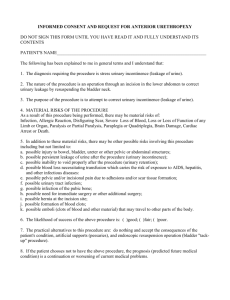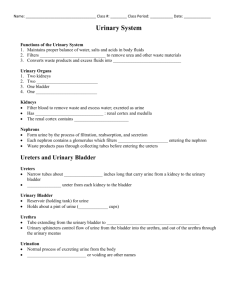urinary_incontinence
advertisement

Customer Name, Street Address, City, State, Zip code Phone number, Alt. phone number, Fax number, e-mail address, web site Urinary Incontinence (Involuntary Passage of Urine) Basics OVERVIEW • Loss of voluntary control of urination, usually observed as involuntary urine leakage while resting SIGNALMENT/DESCRIPTION OF PET Species • Dogs • Cats—rare Breed Predilections • Medium- to large-breed dogs most often affected Mean Age and Range • Most common in middle-aged to old, spayed female dogs; also observed in juvenile females and (rarely) cats or neutered male dogs Predominant Sex • May affect more than 20% of spayed female dogs, especially large-breed dogs SIGNS/OBSERVED CHANGES IN THE PET • Urine dribbling without the pet's control • Wet hair coat on lower abdomen, area between rear legs and onto rear legs; inflammation of skin (known as “dermatitis”) in these areas; pet may lick affected areas • Evidence of urine wet spots or puddles in bedding, where pet was sleeping or sitting, other locations in house • May have signs of urinary tract infection (such as straining to urinate, blood in the urine, painful urination) • Urine scald (skin condition that looks like a burn due to the irritation of urine on the skin) • Inflammation of the skin and moist tissues of the vulva or the prepuce (around the penis) • Leakage may be worse after the pet drinks lots of water or exercises strenuously CAUSES Nervous-System Disorders • Disruption of nerves involved in storage of urine in the bladder or act of urination • Lesions of the sacral spinal cord, such as a birth defects; cauda equina syndrome, a group of disorders in which the lumbosacral vertebral canal is narrowed, resulting in pressure on the nerve roots as they leave the spinal cord; lumbosacral intervertebral disk disease; or traumatic fractures or dislocation can result in a flabby, overdistended urinary bladder; urine retention and overflow incontinence develop • Lesions in the brain may affect voluntary control of voiding, usually resulting in frequent, involuntary urination or in leakage of small volumes of urine Urinary Bladder-Storage Disorders • Poor accommodation of urine during storage or urinary bladder overactivity (so-called “overactive bladder” or “detrusor instability”) leads to frequent leakage of small amounts of urine • Urinary tract infections; chronic inflammatory disorders, such as “chronic cystitis”; cancer involving the bladder; pressure on the bladder from masses or fat; and chronic partial obstruction of the urethra (the tube from the bladder to the outside, through which urine flows out of the body) • Underdevelopment of the bladder (known as “congenital urinary bladder hypoplasia”) may accompany other congenital (present at birth) developmental disorders of the urinary and reproductive tracts • The detrusor muscle acts to squeeze the bladder to expel urine; disorders of this muscle (known as “idiopathic detrusor instability”) has been associated with feline leukemia virus (FeLV) infection in cats and unknown causes in dogs Urethral Disorders • The urethra is the tube from the bladder to the outside, through which urine flows out of the body • Intermittent urinary incontinence is observed if urethral closure provided by urethral smooth muscle, striated muscle, and connective tissue does not prevent leakage of urine during storage • Examples—underdevelopment of the bladder (congenital urinary bladder hypoplasia); acquired (develops during life/after birth) urethral incompetence (such as reproductive hormone–responsive urinary incontinence); urinary tract infection or inflammation; prostatic disease or prostatic surgery (male dogs) Anatomic or Structural Disorders • Developmental or acquired anatomic abnormalities that divert urine from normal storage mechanisms or interfere with urinary bladder or urethral function • The ureters are the tubes from the kidneys to the bladder; during development, they may not attach to the bladder properly or may attach to reproductive organs instead; when this occurs, they are called “ectopic ureters” and one or both can terminate in the distal urethra, uterus, or vagina • Patent urachal remnants divert urine outflow to the umbilicus • Abnormalities of the vagina, bladder or urethra • Intrapelvic bladder neck location may contribute to urine leakage due to urethral incompetence (the inability of the urethra to prevent urine flow) • Conformation abnormalities of the vulva or tissues around the vulva may contribute to urine pooling and intermittent urine leakage Urine Retention • Overflow observed when pressure within the bladder exceeds the ability of the sphincter and urethra to prevent urine flow Mixed Urinary Incontinence • Mixed or multiple causes of urinary incontinence are observed in people and probably occur in dogs and cats; combinations of urethral and bladder-storage disorders and combinations of anatomic or structural and functional disorders are most likely RISK FACTORS • Neutering is the main risk factor for urinary incontinence; however, many spayed female dogs do not develop incontinence • Early spay (surgical procedure is removal of ovaries and uterus; known as an “ovariohysterectomy”) in puppies less than 3 months of age has been shown to increase the risk of urinary incontinence in female dogs • Conformational characteristics (such as bladder neck position, urethral length, and vaginal abnormalities) may increase the risk of urinary incontinence in female dogs • Obesity may increase the risk of urinary incontinence in spayed female dogs • Other possible risk factors for urethral incompetence include breed, large body size, increased urination (known a “polyuria”) and early tail docking Treatment HEALTH CARE • Your pet's veterinarian will assess your pet for potential causes of urinary incontinence and contributing factors • Most cases will be managed successfully with medication • Some cases will require surgical correction of anatomic problems, or injection of bulking material (such as collagen) into the urethra to prevent leakage • Usually as outpatient • Address partial obstructive disorders and primary nervous system disorders specifically, if possible • Identify urinary tract infection and treat appropriately DIET • Weight management to prevent or treat obesity may decrease risk of urinary incontinence SURGERY • Developmental urinary tract disorders (such as ectopic ureters and congenital urethral hypoplasia) often can be corrected surgically; functional abnormalities of urethral competence or urinary bladder storage function may accompany the anatomic or structural disorder and require medical treatment • Surgical procedures and prosthetic sphincter implantation have been described for the treatment of incontinence that is poorly responsive to medical treatment; however, poor improvement has been seen in longterm follow-up Medications Medications presented in this section are intended to provide general information about possible treatment. The treatment for a particular condition may evolve as medical advances are made; therefore, the medications should not be considered as all inclusive URETHRAL INCOMPETENCE • Manage with reproductive hormones (such as stilbestrol, diethylstilbestrol, conjugated estrogens, estriol, and testosterone) or α-adrenergic agents (such as phenylpropanolamine, phenylephrine, pseudoephedrine) • Reproductive hormones and α-adrenergic agents can be administered in combination for a synergistic therapeutic effect, where multiple medications have a better effect than the single medications alone • Imipramine, a tricyclic antidepressant (TCA) with anticholinergic and α-agonist actions, provides an alternative method of treatment • Deslorelin also has been used in cases that respond poorly to other medications DETRUSOR INSTABILITY • Manage with anticholinergic or antispasmodic agents (such as oxybutynin, propantheline, imipramine, flavoxate, and dicyclomine) • Tolterodine—has not been used widely in dogs PROSTATIC DISEASE • Antibiotics for the treatment of infection/inflammation of the prostate (known as “prostatitis”) or prostatic abscesses • Drugs to treat benign prostatic hyperplasia (“enlarged prostate”) and to cause enlarged prostate gland to return toward normal size, such as finasteride Follow-Up Care PATIENT MONITORING • Pets receiving α-adrenergic agents—observe during initial treatment period for adverse effects of the drug, including rapid heart rate, anxiety, and high blood pressure (known as “hypertension”) • Pets receiving long-term estrogen—initial, 1 month, and periodic complete blood counts • Periodic urinalysis and urine bacterial culture (to check for possible urinary tract infection) • Take your pet to the veterinarian if you notice an increase in frequency of urination, an increase in urine leaking, or blood in the urine • Once a therapeutic effect has been observed, slowly reduce the dosage and frequency of administration of medications to the minimum required to control signs of incontinence; dosage and frequency of administration should be changed under the direction of your pet's veterinarian • Consider combination treatment (α-adrenergic agents with reproductive hormones or anticholinergic agents), deslorelin or surgical options, if poor response to single-agent medication POSSIBLE COMPLICATIONS • Recurrent and ascending urinary tract infection • Urine scald (skin condition that looks like a burn due to the irritation of urine on the skin) • Inflammation of the skin (dermatitis) and moist tissues of the vulva • Inflammation of the skin (dermatitis) on lower abdomen, area between rear legs and rear legs • Unmanageable incontinence EXPECTED COURSE AND PROGNOSIS • Most dogs with urinary incontinence will respond well to medications and have complete resolution of incontinence (with rare lapses) • Expect excellent response to medical treatment in 60–90% of treated pets • Some dogs will require an adjustment in medication dose or type over time (years) • A smaller percentage of dogs will not respond well to medication and will require combination medications, collagen injections or surgical procedures to improve continence; these dogs usually will be “improved,” but not “cured” • The prognosis for improvement is less optimistic for cats and for male dogs Key Points • Loss of voluntary control of urination, usually observed as involuntary urine leakage • Medium- to large-breed dogs most often affected • Most common in middle-aged to old, spayed female dogs • Obesity may increase the risk of urinary incontinence in spayed female dogs • Urinary tract infection is a possible complication of urinary incontinence Enter notes here Blackwell's Five-Minute Veterinary Consult: Canine and Feline, Fifth Edition, Larry P. Tilley and Francis W.K. Smith, Jr. © 2011 John Wiley & Sons, Inc.






